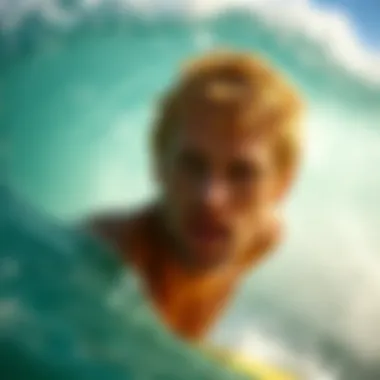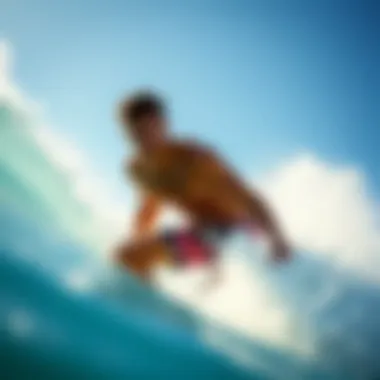The Best Sunblock Choices for Surfers: A Complete Guide


Intro
When it comes to surfing, the thrill of riding the waves is often accompanied by an age-old adversary: the sun. Spending hours in the bright sunlight can lead to skin damage and other long-term health issues. This is why selecting the right sunblock is paramount for surfers. Understanding the unique aspects of water sports, from the type of formulations available to the importance of SPF ratings and environmental impact, can make a world of difference in your sun protection strategy.
Surfers often find themselves in a constant battle between enjoying the surf and safeguarding their skin. Fortunately, the sunblock market has evolved significantly, allowing avid wave riders to enjoy both without compromise. With so many options available, it’s essential to cut through the noise and identify the best products tailored specifically for ocean conditions.
In the sections that follow, we’ll explore the nuances of sun protection for surfers—focusing on effective ingredients, formulations that actually work in the water, top-rated products, and a glance at eco-friendly alternatives.
Tips and Techniques
Beginner Tips for Watersports
Starting out in the world of surfing can be intimidating, but a few simple sun protection principles can set the tone for a healthier experience. Here are some beginner tips to consider:
- Choose a Water-Resistant Formula: Ideally, select sunblocks with labels that state they last up to 80 minutes in water. This can help you avoid reapplying every half-hour after falling off the board.
- Apply Generously: Many people under-apply sunblock, which means they don't get the full SPF protection. A rough guide is to use about an ounce (that’s a shot glass full) for your body.
- Timing is Key: Put your sunblock on at least 30 minutes before hitting the waves to allow your skin to absorb the product properly.
Advanced Techniques for Mastery
For those who are more seasoned in their surfing journey, understanding the environmental impact and advanced formulas becomes key. Here are some advanced techniques to maximize protection while enjoying the ocean:
- Look for Reef-Safe Products: Chemicals like oxybenzone and octinoxate have been linked to coral reef damage. Opt for alternatives labeled reef-safe , which commonly feature zinc oxide or titanium dioxide as the active ingredient.
- Consider Spray versus Lotion: Some advanced surfers prefer spray formulations for easy application and less oily texture. However, it’s essential to ensure that the sprays are water-resistant.
- Keep a Backup: If you’re planning on a long surf session, keep a small tube in your surfboard bag for any touch-ups you may require throughout the day.
"Preparation is the key to success. Don’t let the sun steal your surf experience!"
Understanding and employing these tips can help set the stage for both enjoyable surf sessions and long-term skin health. Now that we’ve got a good grip on the techniques suited for surfers, let’s shift gears and explore essential safety measures in the water.
Understanding Sun Exposure
Understanding sun exposure is crucial for surfers. The ocean's reflection intensifies UV rays, making surfers particularly vulnerable to sunburn and longer-term skin damage. Sun exposure encompasses various factors including UV radiation intensity, duration of exposure, and time of day. With this understanding, surfers can better protect their skin and overall health.
The Science of UV Radiation
Ultraviolet (UV) radiation comes from the sun, and it is categorized into three types: UVA, UVB, and UVC. UVA rays penetrate the skin deeply, leading to premature aging and skin cancer, while UVB rays are primarily responsible for sunburn. Notably, UVC rays are absorbed by the Earth’s atmosphere and do not reach the ground.
When surfers are in the water, the sun's rays can hit from above and below, enhancing exposure. The reflective nature of water amplifies UV radiation, increasing the risk of skin damage. This makes understanding the intensity and effects of UV radiation vital for surfers who spend long hours on the waves.
The Importance of Sun Protection
Proper sun protection is not just about avoiding a painful burn; it encompasses long-term skin health as well. Surfers are at a greater risk for skin cancers due to prolonged UV exposure. According to the Skin Cancer Foundation, melanoma is one of the most common cancers among young adults aged 25 to 29, especially among those who engage in outdoor sports.
Protecting your skin is essential for maintaining overall health and preventing potential skin issues later in life. Whether using sunblock, wearing protective clothing, or seeking shade during peak hours, each method plays a part in reducing skin cancer risks.
As surfers, understanding the sun's impact on skin health fosters a culture of safety and awareness within the sport. When you hit the waves, knowing how to shield your skin effectively can ensure you enjoy surfing for years to come.
"An ounce of prevention is worth a pound of cure."
In summary, with a clear grasp of UV radiation and the importance of sun protection, surfers can navigate their sun care strategies more effectively. The right sunblock combined with conscious practices will keep you surfing safely under the sun.
Choosing the Right Sunblock


Selecting the proper sunblock is crucial for surfers, who face the sun’s relentless rays while washing away in the waves. The right formula can shield your skin from harmful UV radiation, allowing you to enjoy surfing without compromising your health or performance. Factors such as formuulation type, SPF ratings, and water resistance properties play an important role in determining the effectiveness of a sunblock. Making an informed choice ensures that surfers remain safe from sunburns and long-term skin damage, empowering them to ride the tide confidently.
Physical vs. Chemical Sunscreens
When it comes to sun protection, surfers often grapple with the choice between physical and chemical sunscreens.
- Physical Sunscreens contain minerals such as zinc oxide or titanium dioxide. They sit atop the skin as a barrier blocking UV rays and are often touted for their immediate effectiveness. Surfers might prefer them due to their longer-lasting formula when exposed to water.
- Chemical Sunscreens, on the other hand, absorb UV rays through their chemical filters before they can affect the skin, often leaving less of a white cast. However, they take about 20 minutes to start working, which may be less convenient for someone eager to catch the first wave.
Many surfers consider the irritation potential too. Physical formulas might be gentler for sensitive skin, while chemical options can irritate when applied excessively or on broken skin. It's essential to test different types personally to find what works best for your skin type.
SPF Ratings Explained
SPF, or Sun Protection Factor, provides a numerical understanding of how long a sunscreen can theoretically protect your skin compared to if you weren't using any product at all. For instance, an SPF of 30 means you can stay in the sun 30 times longer without getting burned than without using sunscreen. However, it’s worth considering that SPF is not an absolute indicator of safety; rather, it’s a guideline.
- Low SPF (15-30): Suitable for shorter exposures or for those with naturally higher skin protection.
- Medium SPF (30-50): A safe bet for daily use, balancing solid protection while allowing for extended fun in the sun.
- High SPF (50+): Offers heightened protection, appealing for surfers who spend hours battling the waves.
It wouldn’t hurt to remember that no sunscreen completely blocks UV rays. So even at the highest SPF, pairs it with smart practices like wearing a rash guard or a hat to enhance protection.
Water Resistance Properties
Sunscreen labeled as water-resistant can withstand some exposure to water or sweat. For surfers, this property is non-negotiable. Water-resistant formulations maintain their protection for 40 to 80 minutes when immersed in water. Not all sunscreens are created equal; a surfer’s skin deserves careful consideration when making choices.
- 40-Minute Water Resistance: Works for moderate exposure to water; think splashes or surf sessions in mild conditions.
- 80-Minute Water Resistance: Ideal for those who truly brave the waves, offering reliable protection for long sessions, even in stronger conditions.
Be aware that reapplication is still advisable post-surfing. Despite claims of water resistance, some product can wear off after repeated contact with water or may dissolve into the ocean. Thus, reapplying is the best way to avoid a nasty sunburn and preserve the integrity of your skin.
"Finding the right sunblock isn’t just about skin protection; it's about enjoying the ride without worry."
In summary, making an educated decision on sunblock involves understanding the differences in formulations, SPF ratings, and water-resistant capabilities. Knowledge is power, especially when it comes to safeguarding your skin against the scorching sun in your pursuit of serendipitous waves. Choosing wisely could very well be the difference between a great surf experience and a sunburned nightmare.
Key Ingredients to Look For
Selecting the right sunblock requires more than just random guesswork; you'd want to zero in on key ingredients that provide specific benefits and protect your skin effectively while riding the waves. This part of the article will delve into essential elements you should note when considering sun protection, emphasizing the science behind each component and its impact on your skin health and performance.
Top Sunblock Recommendations for Surfers
When it comes to surfing, the right sunblock isn’t just a recommendation; it’s an essential part of every surfer's gear. The harsh sun and reflective nature of water can amplify UV exposure, making effective sun protection critical to preventing sunburn and long-term skin damage. Surfers often spend prolonged hours in direct sunlight, so choosing the optimal sunblock can mean the difference between a day filled with fun and one marred by pain or health issues. Hence, knowing which products are reliable can provide peace of mind and allow surfers to focus on their performance in the water.
Review of Leading Brands
In the vast ocean of sun care products, a few brands stand out for their quality, effectiveness, and relevance to the surfing lifestyle. Here are notable brands to consider:
- Neutrogena - Known for its broad spectrum protection, Neutrogena's Beach Defense line is highly regarded among surfers. Its water resistance makes it a favorite for long surf sessions.
- Banana Boat - Particularly noted for its Ultra Sport range, this brand offers high SPF levels alongside excellent water resistance. Surfers can rely on it to stay intact, even after being pounded by waves.
- Zinc Oxide Brands - Products like Raw Elements or SurfDurt which feature zinc oxide are gaining popularity. These options provide a physical barrier and are often made with organic ingredients, appealing to the eco-conscious surfer.
- Coppertone Sport - A stalwart in the world of sun protection, this brand has been reformulated to cater specifically to athletes, ensuring maximum protection even during vigorous activity.
"The right choice of sunscreen can extend your time in the water while keeping your skin healthy."
Comparative Analysis of Popular Products
When sifting through the myriad of choices, it’s crucial to break down their similarities and differences to guide consumers in their purchasing decisions. Here’s a comparative look:
- Ingredient Breakdown
- Texture and Application
- Water Resistance
- Eco-Friendliness


- Neutrogena Beach Defense primarily uses chemical filters which absorb UV rays.
- Raw Elements opts for organic ingredients, making it suitable for both skin and sea life. This brand touts non-nano zinc oxide as its active ingredient, forming a protective barrier against the sun.
- Banana Boat Ultra Sport is known for its smooth application which dries quickly on the skin, avoiding that greasy feeling many surfers dislike.
- Coppertone Sport features a lightweight formula which is easy to spread without feeling heavy.
- Neutrogena and Banana Boat advertise water resistance for up to 80 minutes, translating well to active surfers who are constantly in motion.
- Zinc oxide brands can sometimes require more frequent application as physical sunscreens can wash off more easily than their chemical counterparts.
- Raw Elements and similar brands avoid known harmful chemicals that can damage coral reefs and marine ecosystems, embodying a growing trend toward sustainability within the surfing community.
By comparing these aspects, one can better understand not just the efficacy but also the ethical considerations behind their product choices. Whether you prioritize water resistance or environmentally friendly practices, knowing the distinctions helps in making an informed choice suited to one’s surfing habits.
Application Techniques for Maximum Effectiveness
Understanding how to apply sunblock effectively is crucial for surfers who spend long hours riding the waves. Proper application not only enhances protection but also optimizes the sunblock's performance in real-world conditions. Sunblock is designed to shield against harmful UV rays, but its effectiveness can vary significantly based on how it is applied.
How Much to Apply
Surfers often underestimate the amount of sunscreen needed to achieve that sought-after protective barrier. Research suggests that for full-body coverage, a generic guideline is to use about one ounce—that's roughly the amount that can fill a shot glass. For those who find it hard to visualize, think of it as enough to cover your entire body, from the neck down, not just a sparing dollop here and there.
Proper application involves spreading an even layer over all exposed skin. Pay special attention to commonly neglected areas such as the tops of the ears, the back of the legs, and the neck. It's also a good idea to have a friend check hard-to-see spots, ensuring full coverage everywhere.
Timing Your Application
Timing might be just as essential as how much sunblock you apply. For optimal results, apply sunblock at least 15 to 30 minutes before heading out into the waves. This waiting period allows the ingredients to absorb fully into the skin, maximizing their protective abilities. If you've ever applied sunscreen and felt it washing off shortly after getting in the water, it might be due to an improper application time.
Another tip: don't skip areas! Don’t rush through application; focus, especially on the areas that the sun often loves to beam down on, like your shoulders and back. Not only can sun exposure be uncomfortable, but it can lead to long-term skin damage.
Reapplication Strategies After Surfing
Once you're in the water, the sun can be relentless. Even the best sunblock isn't invincible, so knowing when and how to reapply can be a game-changer. It is recommended to reapply sunblock every two hours or immediately after sweating heavily or exiting the water. This is particularly important for surfers who often engage in activities causing them to wipe off the sunblock.
Many may find it helpful to set a timer on their watches or smartphones as a reminder. One handy strategy is to use a water-resistant sunblock, but remember that no sunblock is entirely water-proof. After a long surf session, there’s a good chance you need to refresh your coverage.
Here’s a quick checklist for reapplying:
- Pick a shady spot if possible to minimize direct sunlight exposure while reapplying.
- Use similar amounts as with the initial application.
- Don’t forget areas like the tops of your hands and your feet—often neglected but vulnerable.
Taking these techniques into account can dramatically improve your sun safety while surfing. Doing so isn’t just about comfort—it's about protecting your skin from potential damage caused by ultraviolet rays. A healthy balance of application techniques will equip you to ride the waves longer without the worry of sunburn or skin damage.
"Surfers have a unique relationship with the sun; it's essential to respect its power while enjoying its warmth."
For further reading about optimal sun protection strategies, you can visit CDC: Skin Cancer Prevention, or Skin Cancer Foundation.
Engaging in these practices will help ensure the sun never gets the better of you on your next surf adventure!
Environmental Considerations
Understanding the environmental impact of sunblock is essential for surfers who wish to protect not only their skin but also the ecosystem they enjoy. Surfing is inherently linked to the ocean and its health, and choosing sunscreens wisely contributes to preserving marine life. The connection between the products we apply and their effects on the environment cannot be overlooked.
Impact of Sunscreens on Marine Life
Many surfers may not realize that a considerable percentage of sunscreens contain chemicals that can be detrimental to marine ecosystems. Compounds like oxybenzone and octinoxate have been shown to cause coral bleaching, hinder coral recruitment, and adversely affect various marine species. These chemicals can enter the ocean through direct runoff from the body or indirectly from wastewater treatment processes.


Research from sources like the National Oceanic and Atmospheric Administration (NOAA) indicates that just a small amount of sunscreen can be harmful to coral reefs. When coral reefs are compromised, the entire marine ecosystem suffers. Fish, turtles, and other marine life rely on healthy coral habitats for shelter and food.
"A mere 25,000 people applying sunscreen on a beach can lead to enough pollution to impact marine organisms in the surrounding waters."
Surfers should ask themselves how their choices can protect the environment while enjoying their sport. This means it’s critical to take into account the type and composition of the sunblock used, ensuring it does not contain harmful ingredients.
Choosing Eco-Friendly Options
Opting for eco-friendly sunscreens is becoming not only a trend but a necessity for ocean enthusiasts. Several brands have risen to the occasion by offering sunblocks that utilize naturally derived ingredients, which are less harmful to marine ecosystems. Ingredients like zinc oxide and titanium dioxide are often preferred because they are mineral-based and less likely to cause harm to aquatic life.
When selecting eco-friendly options, keep the following points in mind:
- Look for "Reef Safe" Labels: These products are formulated without harmful chemicals and have been tested for safety in marine environments.
- Check Ingredient List: Avoid sunscreens that list oxybenzone, octinoxate, and other harmful agents. Familiarize yourself with alternatives that prioritize safety for marine habitats.
- Read Brand Statements: Many brands are transparent about their commitment to sustainability. They may source ingredients responsibly and practice environmentally conscious packaging methods.
Beyond just choosing the right product, adopting additional practices like reducing plastic use on the beach and minimizing pollution can further help in preserving the ecosystems we love.
Other Protective Measures
As surfers glide across the waves, they often focus on the thrill of riding and the splash of water, neglecting an equally critical aspect: protection from the sun. While sunblock offers a robust line of defense, it isn’t the only measure surfers should consider. Other protective measures can complement sunblock and enhance their overall shield against harmful UV rays. In this section, we will delve into two key areas that can significantly help mitigate sun exposure: wearing UV-blocking clothing and utilizing surf accessories designed for extra protection.
Wearing UV-Blocking Clothing
Embracing the sun isn't without its pitfalls when you're out for hours on end. Wearing UV-blocking clothing has emerged as one of the most pivotal adjustments for surfers. These garments are crafted to shield the skin from harmful rays, often with a UPF (Ultraviolet Protection Factor) rating that specifically measures effectiveness against UV radiation. The higher the UPF value, the better the protection.
- Comfort and Performance: Most UV-blocking clothing is made from lightweight and breathable materials. Surfers often find that these fabrics not only protect their skin but enhance their performance in the water, allowing for better movement and ease.
- Longevity: Unlike sunblock, which needs reapplication every couple of hours, UV-blocking clothing provides all-day protection. This ensures that even when you’re battling the waves, you’re not losing out on vital protection.
- Sustainability: Many brands are branching into eco-friendly options. Recycling plastic bottles into fibers for swimwear has become a trend, providing the surfing community with guilt-free choices.
To maximize the benefits, it’s wise to consider long-sleeved rash guards or full-body suits, depending on personal preference and weather conditions. After all, keeping the sun off the skin is an immediate way to lower the risk of sunburn and long-term damage.
Utilizing Surf Accessories for Protection
Accessories can play a significant role in enhancing protection against UV exposure. Surfers often overlook them, but a few small additions can make a noteworthy difference in ensuring skin safety.
- Hats and Visors: Though not typically associated with surfing, a good hat can do wonders. Wide-brimmed hats offer shade to the face and neck, two areas particularly susceptible to sunburn. When choosing, look for hats with UPF ratings for added defense.
- Sunglasses: Protecting your eyes is crucial. Not just any pair will do, though. It’s essential to select sunglasses that offer 100% UV protection. The glare from the sun reflecting off the water can be intense, and quality sunglasses can prevent long-term damage to the eyes.
- Neck Gaiters: Increasingly popular among surfers, these versatile pieces are adept at covering the neck and can even be pulled up over the face. They provide warmth during cooler sessions and protection from UV rays on those sizzling sunny days.
"Even the most avid surfers can overlook the toll that the sun takes on their skin. Utilizing additional protective gear is not just a precaution but a necessity for long-term health."
Epilogue
By incorporating UV-blocking clothing and relevant accessories into their daily routine, surfers not only enhance their protection against sun damage but also contribute to their overall comfort and performance in the water. It’s not just about slathering on sunblock—protecting oneself while enjoying the ocean requires a multi-faceted approach that considers every aspect of exposure.
The End
When it comes to enjoying the waves and soaking up sun, understanding the significance of sun protection cannot be overstated for surfers. The right sunblock is not merely an accessory; it’s an essential part of a surfer's toolkit. With extended hours spent under the sun, surfers are prone to skin damage, ranging from sunburn to more severe long-term consequences like skin cancer. Thus, the incorporation of high-quality sunblock into your routine is not just about comfort but about safeguarding your health.
Identifying the optimal sunblock involves recognizing key elements such as SPF ratings, water resistance, and ingredient transparency. High SPF provides a greater shield against harmful UV rays, essential for those who spend hours on the ocean's surface. Water-resistant formulas stand out as crucial for surfers, allowing for continued protection despite constant exposure to water.
Opting for products with natural ingredients may also enhance safety for both skin and the marine environment. Considerations around eco-friendly options reflect a growing awareness within the surfing community about sustaining oceanic health. Environmental awareness and personal health should go hand-in-hand, steering surfers toward choices that respect nature while protecting themselves.
As evidenced by the discussion throughout this article, prioritizing sun protection significantly contributes to the overall surfing experience. Surfers equipped with knowledge about the best sunblock options can enjoy their time in the ocean with greater peace of mind. So, grab that best sunblock, slather it on, and ride those waves with confidence, knowing you've made a smart and informed choice.
Final Thoughts on Sun Protection for Surfers
In summary, the topic of sun protection for surfers is both critical and multifaceted. Surfers face unique challenges and risks that necessitate tailored solutions for effective protection against the sun. Understanding the criteria for selecting suitable sunblocks, such as formulation and intended use, is key. It ensures that surfers are not just protected but can continue to thrive in their activities without worry.
Ultimately, the choice in sunblock spells the difference between a day filled with joy and one plagued by discomfort. It is imperative to remain informed about options that cater specifically to aquatic sports. Embracing sustainability in these choices positions surfers as advocates for marine conservation, making waves in more ways than one.
> Choosing the right sunblock isn’t just a matter of skin health; it reflects a deeper commitment to the ocean we all love to surf in.















